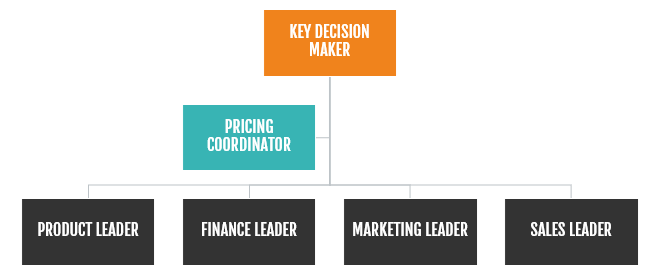Pricing is core to your business, and your SaaS pricing team should reflect that.
Think about it: product development, sales team activities, marketing strategy and finances. All heavily impacted by the way you decide to price your SaaS solution.
Unfortunately it's common for SaaS pricing to be done on an ad-hoc basis, without a formal team in place, and debate between far too many people with competing incentives: this results in pricing that's largely a result of ineffective compromises, guess work, how competitors price and "what feels right".
Another common problem is SaaS companies placing pricing within one core function (e.g. finance, marketing, product, or sales). This almost always results in a narrow view of pricing.
A sales team given responsibility for pricing might focus on what maximises initial sales, largely neglecting Customer Lifetime Value, and without thinking about what their decisions mean for product development, for example.
Similarly, a finance team put in charge of pricing might well excel at the technical optimisation work, and design a model that looks great in theory. But that totally disregards the customer, and how they really think/act.
A disaster for SaaS companies who want to maximise their growth and profitability, when a 1% improvement in pricing results in an 11% increase in profit.
To develop, implement and continually optimise your SaaS pricing strategy, you need to establish a cross functional team. A team that considers all the details of your pricing, ensures representation of all functions across the company, and manages the pricing process end-to-end.
So What does an Effective SaaS Pricing Team Look Like?
Top performing companies keep their pricing team small, with a key decision maker to take the final calls and a pricing coordinator to manage what's needed for day-to-day execution:

- Key Decision Maker - in a smaller SaaS business, this is almost always the CEO or Founder. In larger companies, this is often still the CEO, but can also be a senior level VP or C-level executive in Product or Marketing.
Why so senior? It's essential the decision maker is at an executive level, with the internal authority to make things happen. This is the person who makes your final pricing decisions and takes ownership of your pricing strategy, to ensure the team doesn't face option paralysis.
Why Product or Marketing, if not the CEO? This role should always be held by someone with a long term view of your company, rather than someone more focused on making shorter term progress. Usually it's the CEO, Product and Marketing Leaders who have the longest view of the company, and who are best able to see the company from a customer's perspective: an essential for pricing well.
To give an example of how it can be a problem to put a different function leader in this role: a Sales leader might be very reluctant to make a change to the way you bundle your product features for fear of its impact on next quarter's numbers, even though it might be the right long term decision to grow your existing accounts. - Pricing Coordinator - in a smaller SaaS business, this will typically be someone from the Product or Marketing team that can dedicate a significant portion of their time to ensuring pricing execution goes smoothly. Beyond $10m in ARR, you should hire someone fulltime for this role. In enterprise organisations, this person may head up a (separate) team of pricing specialists.
- Product Leader - Your "Head of Product", whether that's SVP, VP, C-level or equivalent. Your product decisions should be driven by your pricing in a significant way, and it's your product team who often have the best understanding of how your customers use and get value from your solution.
- Finance Leader - Your "Head of Finance", whether that's CFO, SVP, or equivalent. The way you price will have implications for finance, both short and long-term, and finance teams are usually well suited to modelling the impact of price changes. Different approaches mean different trade-offs.
- Marketing Leader - Your "Head of Marketing", whether that's CMO, SVP, VP or equivalent. Marketing is responsible for your pricing page and positioning. Pricing is important at every stage of the marketing funnel, and like the product team, your marketing leader should have a detailed understanding of your Ideal Customers and Buyer Personas.
- Sales Leader - Your "Head of Sales", whether that's C-level, SVP, VP or equivalent. Any decisions you make about your pricing will have a significant impact on Sales, so it's essential they're involved. Sales leaders also have a good understanding of customer objections/needs, and what helps to close deals.
How should the Pricing team Get Started?
You should never stop working on your pricing, which means that the team must be a permanent one. If your pricing is starting from an under-performing baseline (most are, if pricing isn't already a core competency), then a first project is likely to be a major one. Longer term, the team should be overseeing:
- The ongoing collection and analysis of customer data
- Pricing market research
- At least several minor pricing changes per year, and 1-2 major changes a year
Most companies find it helpful to use a framework (like the Pricing Canvas) to give a structure to their decision making, and can benefit from starting out working with a SaaS pricing consultant. An effective consultant will help guide the new pricing team, develop internal pricing skills, provide an external sounding board and get your SaaS pricing team up-and-running smoothly and effectively.




